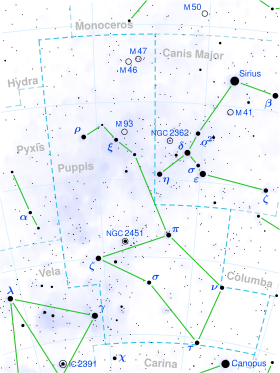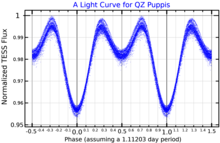
| |
| Observation data Epoch J2000 Equinox J2000 | |
|---|---|
| Constellation | Puppis |
| Right ascension | 07 52 38.64663 |
| Declination | −38° 51′ 46.1305″ |
| Apparent magnitude (V) | 4.47 - 4.54 |
| Characteristics | |
| Spectral type | B2.5V |
| U−B color index | −0.68 |
| B−V color index | -0.20 |
| Variable type | ellipsoidal |
| Astrometry | |
| Radial velocity (Rv) | +29.50 km/s |
| Proper motion (μ) | RA: −8.92 mas/yr Dec.: +3.34 mas/yr |
| Parallax (π) | 5.03 ± 0.19 mas |
| Distance | 650 ± 20 ly (199 ± 8 pc) |
| Absolute magnitude (MV) | −2.00 |
| Details | |
| Mass | 6.0 M☉ |
| Radius | 7.3 R☉ |
| Luminosity | 2,268 L☉ |
| Surface gravity (log g) | 3.5 cgs |
| Temperature | 15,254 K |
| Metallicity | −0.15 dex |
| Rotational velocity (v sin i) | 151 km/s |
| Age | 24.1 Myr |
| Other designations | |
| b Puppis, QZ Pup, CD−38°3769, GC 10661, GSC 07646-03591, HIP 38455, HR 3084, HD 64503, NSV 3789, SAO 198545 | |
| Database references | |
| SIMBAD | data |
QZ Puppis (QZ Pup, b Pup) is a class B2.5V (blue main-sequence) star in the constellation Puppis. Its apparent magnitude is 4.5 and it is approximately 650 light years away based on parallax.

QZ Puppis was identified as a small-amplitude variable star in 1974, but the nature of the variability was unclear. It was thought to be a spectroscopic binary on the basis of variability in the radial velocity of its spectral lines. As a hot B-class main sequence star with variable spectral lines, it was suspected of being a β Cephei variable but this classification was repeatedly rejected. The short-period sinusoidal variations in brightness with an amplitude of 0.03 magnitudes were interpreted as ellipsoidal variations as the star, distorted by a close companion, rotates with a period of 1.1 days. Later analysis of Hipparcos photometry detected shallow eclipses.
The companion to QZ Puppis is only known from its effect on the visible star as they orbit. The primary shows radial velocity variations of 71 km/s as it orbits every 1.112 days.
References
- ^ Van Leeuwen, F. (2007). "Validation of the new Hipparcos reduction". Astronomy and Astrophysics. 474 (2): 653–664. arXiv:0708.1752. Bibcode:2007A&A...474..653V. doi:10.1051/0004-6361:20078357. S2CID 18759600. Vizier catalog entry
- ^ Samus, N. N.; Durlevich, O. V.; et al. (2009). "VizieR Online Data Catalog: General Catalogue of Variable Stars (Samus+ 2007-2013)". VizieR On-line Data Catalog: B/GCVS. Originally Published in: 2009yCat....102025S. 1. Bibcode:2009yCat....102025S.
- Hoffleit, D.; Warren, W. H. (1995). "VizieR Online Data Catalog: Bright Star Catalogue, 5th Revised Ed. (Hoffleit+, 1991)". VizieR On-line Data Catalog: V/50. Originally Published in: 1964BS....C......0H. 5050. Bibcode:1995yCat.5050....0H.
- ^ Mermilliod, J. C. (2006). "VizieR Online Data Catalog: Homogeneous Means in the UBV System (Mermilliod 1991)". VizieR On-line Data Catalog: II/168. Originally Published in: Institut d'Astronomie. 2168. Bibcode:2006yCat.2168....0M.Vizier catalog entry
- Kharchenko, N.V.; Scholz, R.-D.; Piskunov, A.E.; Röser, S.; Schilbach, E. (2007). "Astrophysical supplements to the ASCC-2.5: Ia. Radial velocities of ~55000 stars and mean radial velocities of 516 Galactic open clusters and associations". Astronomische Nachrichten. 328 (9): 889. arXiv:0705.0878. Bibcode:2007AN....328..889K. doi:10.1002/asna.200710776. S2CID 119323941.
- Anderson, E.; Francis, Ch. (2012). "XHIP: An extended hipparcos compilation". Astronomy Letters. 38 (5): 331. arXiv:1108.4971. Bibcode:2012AstL...38..331A. doi:10.1134/S1063773712050015. S2CID 119257644. Vizier catalog entry
- ^ Vallenari, A.; et al. (Gaia collaboration) (2023). "Gaia Data Release 3. Summary of the content and survey properties". Astronomy and Astrophysics. 674: A1. arXiv:2208.00211. Bibcode:2023A&A...674A...1G. doi:10.1051/0004-6361/202243940. S2CID 244398875. Gaia DR3 record for this source at VizieR.
- Anders, F.; et al. (August 2019). "Photo-astrometric distances, extinctions, and astrophysical parameters for Gaia DR2 stars brighter than G = 18". Astronomy & Astrophysics. 628: A94. arXiv:1904.11302. Bibcode:2019A&A...628A..94A. doi:10.1051/0004-6361/201935765. eISSN 1432-0746. ISSN 0004-6361.
- Glebocki, R.; Gnacinski, P. (2005). "VizieR Online Data Catalog: Catalog of Stellar Rotational Velocities (Glebocki+ 2005)". VizieR On-line Data Catalog: III/244. Originally Published in: 2005csss...13..571G; 2005yCat.3244....0G. 3244. Bibcode:2005yCat.3244....0G.
- Tetzlaff, N.; Neuhäuser, R.; Hohle, M. M. (2011). "A catalogue of young runaway Hipparcos stars within 3 kpc from the Sun". Monthly Notices of the Royal Astronomical Society. 410 (1): 190–200. arXiv:1007.4883. Bibcode:2011MNRAS.410..190T. doi:10.1111/j.1365-2966.2010.17434.x. S2CID 118629873. Vizier catalog entry
- "MAST: Barbara A. Mikulski Archive for Space Telescopes". Space Telescope Science Institute. Retrieved 8 December 2021.
- ^ Haefner, R.; Drechsel, H. (1986). "Further evidence for the binary nature of HR 3084". Astrophysics and Space Science. 121 (2): 205. Bibcode:1986Ap&SS.121..205H. doi:10.1007/BF00653693. S2CID 120352239.
- Telting, J. H.; et al. (June 2006). "A high-resolution spectroscopy survey of β Cephei pulsations in bright stars". Astronomy and Astrophysics. 452 (3): 945–953. Bibcode:2006A&A...452..945T. doi:10.1051/0004-6361:20054730. hdl:2066/36162.
- "QZ Pup". International Variable Star Index. AAVSO. Retrieved 2022-10-16.